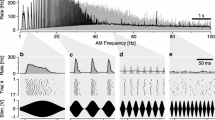Abstract
Experiments on the cercal wind-sensing system of the American cockroach, Periplaneta americana, showed that the firing rate of the interneurons coding wind information depends on the bandwidth of random noise wind stimuli. The firing rate was shown to increase with decreases in the stimulus bandwidth, and be independent of changes in the total power of the stimulus with constant spectral composition. A detailed analysis of ethologically relevant stimulus parameters is presented. A phenomenological model of these relationships and their relevance to wind-mediated cockroach behavior is proposed.








Similar content being viewed by others
Abbreviations
- 2D:
-
two dimensional
- FOWD:
-
fiber-optic wind detector
- GI:
-
giant interneurons
- STA:
-
spike-triggered average
Reference
Camhi JM (1983) Neuroethology: nerve cells and the natural behavior of animals. Sinauer, Sunderland, MA
Camhi JM, Levy A (1989) The code for stimulus direction in a cell assembly in the cockroach. J Comp Physiol A 165:83–97
Camhi JM, Nolen TG (1981) Properties of the escape system of cockroach during walking. J Comp Physiol 142:339–346
Clague H, Theunissen F, Miller JP (1997) Effects of adaptation on neural coding by primary sensory interneurons in the cricket cercal system. J Neurophysiol 77:207–220
Engelmann J, Hanke W, Mogdans J, Bleckmann H (2000) Hydrodynamic stimuli and the fish lateral line. Nature 408:51–52
Fraser PJ (1977) Cercal ablation modifies tethered flight behaviour of cockroach. Nature 268:523
Frisch UU (1995) Turbulence. Cambridge University Press, Cambridge, UK
Gnatzy W, Kamper G (1990) Digger wasp against cricket. 2. An airborne signal produced by a running predator. J Comp Physiol A 167:551–556
Homberg U (1994) Flight-correlated activity changes in neurons of the lateral accessory lobes in the brain of the locust Schistocerca gregaria. J Comp Physiol A 175:597–610
Kolton L, Camhi JM (1995) Cartesian representation of stimulus direction: parallel processing by two sets of giant interneurons in the cockroach. J Comp Physiol A 176:691–702
Kondoh Y, Arima T, Okuma J, Hasegawa Y (1991a) Filter characteristics of cercal afferents in the cockroach. J Comp Physiol A 169:653–662
Kondoh Y, Morishita H, Arima T, Okuma J, Hasegawa Y (1991b) White noise analysis of graded response in a wind-sensitive, nonspiking interneuron of the cockroach. J Comp Physiol A 168:429–443
Kondoh Y, Arima T, Okuma J, Hasegawa Y (1993) Response dynamics and directional properties of nonspiking local interneurons in the cockroach cercal system. J Neurosci 13:2287–2305
Levi R, Camhi J (1996) Producing directed behaviour: muscle activity patterns of the cockroach escape response. J Exp Biol 199:563–568
Levi R, Camhi JM (2000a) Population vector coding by the giant interneurons of the cockroach. J Neurosci 20:3822–3829
Levi R, Camhi JM (2000b) Wind direction coding in the cockroach escape response: winner does not take all. J Neurosci 20:3814–3821
Liebenthal E, Uhlmann O, Camhi JM (1994) Critical parameters of the spike trains in a cell assembly: coding of turn direction by the giant interneurons of the cockroach. J Comp Physiol A 174:281–296
Plummer MR, Camhi JM (1981) Discrimination of sensory signals from noise in the escape system of the cockroach: the role of wind acceleration. J Comp Physiol A 142:347–357
Rieke F, Warland D, Ruyter van Steveninck RR de, Bialek W (1997) Spikes—exploring the neural code. MIT Press, Cambridge, Mass
Rinberg D, Davidowitz H (2000) Do cockroaches ‘know’ about fluid dynamics? Nature 405:756
Rinberg D, Davidowitz H (2002) A stimulus generating system for studying wind sensation in the American cockroach. J Neurosci Methods 121:1–11
Rinberg D, Bialek W, Davidowitz H, Tishby N (2003) Spike sorting in the frequency domain with overlap detection. e-print archive, http://arXiv.org/abs/physics/0306056
Theunissen F, Roddey JC, Stufflebeam S, Clague H, Miller JP (1996) Information theoretic analysis of dynamical encoding by four identified primary sensory interneurons in the cricket cercal system. J Neurophysiol 75:1345–1364
Tritton DJ (1988) Physical fluid dynamics. Oxford University Press
Vedenina VY, Rozhkova GI, Panjutin AK, Byzov AL, Kämper G (1998) Frequency-intensity characteristics of cricket cercal interneurons: low-frequency-sensitive units. J Comp Physiol A 183:553–561
Vickers NJ (2000) Mechanisms of animal navigation in odor plumes. Biol Bull 198:203–212
Volman SF, Camhi JM (1988) The role of afferent activity in behavioral and neuronal plasticity in an insect. J Comp Physiol A 162:781–791
Westin J, Ritzmann RE, Goddard DJ (1988) Wind-activated thoracic interneurons of the cockroach. I. Responses to controlled wind stimulation. J Neurobiol 19:573–588
Acknowledgements
It is our pleasure to acknowledge the many helpful discussions and occasional critique of our work provided by Rob De Ruyter, Tom Adelman, Naama Brenner, Misha Chertkov, and Alan Gelperin at various stages of this work.
Author information
Authors and Affiliations
Corresponding author
Rights and permissions
About this article
Cite this article
Rinberg, D., Davidowitz, H. Wind spectra and the response of the cercal system in the cockroach. J Comp Physiol A 189, 867–876 (2003). https://doi.org/10.1007/s00359-003-0460-9
Received:
Accepted:
Published:
Issue Date:
DOI: https://doi.org/10.1007/s00359-003-0460-9




